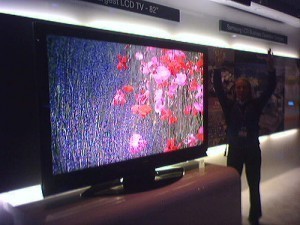Largest LCD TV
The world’s largest LCD TV is the AQUOS by Sharp. It measures 108 inches. The 108-inch Full HD 1080p dimensions are 93.9 inches (w) by 52.9 inches (h).
Overview
LCD stands for liquid crystal display. This is different from the cathode ray tube (CRT) or plasma, its main rival. Liquid crystal display technology is also used in computer monitors. In many ways, this type of TV is just a large monitor coupled with a TV tuner. Several models have the ability to display HD resolutions from a set-top digital display box.
Benefits
CRTs are notorious for their bulk. This is necessary to house the tube in the unit. A 36 inch model can weigh over 230 lbs. By comparison, an LCD set of the same size weighs 37 lbs. These sets can also be hung on walls.
Features
TVs that use liquid crystal displays have a five layer technology. These consist of liquid crystal solution, a colored pixel mask, polarized glass, a backlight and a second sheet of polarized glass.
Every pixel on the screen is equipped with a transistor that controls the crystal’s orientation. Manipulation is done via voltages and electrical charges.
The crystal orientation functions like a shutter; it determines whether backlight can flow or will be blocked. This process is followed regardless of the size, including the world’s largest LCD TV. The backlight goes into specific pixels. These pixels generate the hues that comprise the image.
Other Attributes
The technology generates very little radiation. Compared to plasma TV, very little electricity is used. One of its best features is the non-reflective screen. Simply put, you can place the set in rooms with windows, skylights and glass doors without the annoying reflections. Overhead lighting and lamps do not cast reflections either.
Size
These TVs are available in different sizes. There are 32 inch, 36 inch, 40 inch and 50 inch sets available. There are also 60 inch sets. The typical size used in homes is up to 55 inches. But size is just one factor buyers ought to consider.
A wide viewing angle is desirable so color washout does not occur. Brightness is not a big problem as these TVs are naturally bright and vivid.
The world’s largest LCD TV measures 108 inches, but it may not be long before other models match or surpass it. If buying a set, make sure it is new; older sets suffer from “ghosting”.





